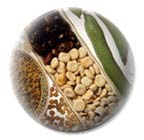- Home
- Introductions

|
Vegetable Seed Production: PrinciplesYou are here: Seed Production: Principles: Cleaning & Storage Cleaning and Storage The physical quality of a seed lot following harvesting, threshing, and drying must be evaluated to determine whether precleaning is necessary. If the seed lot possesses large amounts of inert material such as stones or plant debris, it should be passed over a scalping machine. If the seed possesses undesired appendages like carrot that cause them to clump together, then mechanical debearding is required to ensure free-flow of individual seeds. Impact debearders are also used on multigerm beet seeds to split the fruit into single seed units.
After precleaning vegetable seed crops are conditioned in the same way as other seed crops using the same principles and equipment. Some additional improvements can be made. For example, greater seed density improves the seed quality of lettuce, tomato, and onion crops. This can be accomplished by placing the seed mass into a solution of specific osmotic concentration. The more dense seed fractions are retained and the more buoyant seeds are removed from the top of the solution. After cleaning is completed, vegetable seeds are stored at low moisture content and temperature.
It is not possible to exhaustively study the entire range of seed production schemes utilized in the production of vegetable seeds. Rather, 12 of the most important vegetable families are considered. They generally differ in their vegetative/reproductive structure, and illustrate differing seed production practices. Similarities exist in the seed production of related species and many of the principles detailed here can be extended to similar crops. There are many types of specialized equipment used to harvest, dry, condition, grade, treat, and package vegetable seeds. These PowerPoint presentations show some of the vegetable seed processing equipment manufactured and sold by Seed Processing Holland (SPH) in the Netherlands. Even though SPH is one of the larger companies, there are others that make seed equipment. For example, Oliver Manufacturing in Colorado is also a major producer of seed processing equipment. Please watch the short video describing their seed conditioning equipment and its usage at: https://www.youtube.com/watch?v=smPLayqCxDo. This is long PowerPoint presentation in two parts so please don’t attempt to memorize all the types of equipment. The main purpose of this presentation is to illustrate the many different types of conditioning that seeds undergo as they move from a production field to the consumer. Each presentation is full of video clips demonstrating a wide variety of equipment and crops.
GENERAL REFERENCES Bassett, M. J. 1986. Breeding Vegetable Crops. Avi Publishing, Westport. George, R. A. T. 1985. Vegetable Seed Production. Longman Press, Essex. |